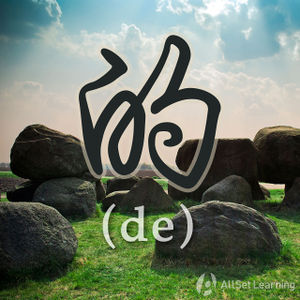Structural particle "de"
The structural particle "de" has three written forms in modern Chinese, each with its own uses:
- The structural particle 的 (most often used for modifying noun)
- The structural particle 得 (most often used with complements)
- The structural particle 地 (most often used for adverbial phrases)
There is also a modal particle 的.
Contents
的
的 (de) is known as 白勺的 (bái-sháo de) in Chinese as it's composed of the characters 白 (bái) and 勺 (sháo). It's used to mark possession or modification. One way to think about 的 (de) is that it works like 's in English (apostrophe s), e.g.
- 小李 的 房子 Xiaoli'e house
This analogy works very well for possession, as it shows how English and Chinese handle possession in a similar way. Just remember that Chinese uses this "possession" far more widely than English. Modifying, describing qualities, and assigning attributes are all handled in the same way as possession, by using 的 (de).
- 红色 的 自行车 red bicycle
Here 的 (de) is used to modify "bicycle" with the color "red." OK, so it's not exactly possession, but the connection is close and clear.
Structure
Although certainly not complete for all uses, this simple structure should help as a general guideline:
的 + Noun
Examples
- 我 的 学校My school
- 我 的 手机My cellphone
- 你 的 咖啡Your coffee
- 我们 的 老师Our teacher
- 他 的 女朋友His girlfriend
- 漂亮 的 衣服Beautiful clothes
- 长 长 的 路A long road
- 蓝 色 的 天A blue day
- 甜 甜 的 苹果A sweet apple
- 我 的 红色 的 裙子My red skirt
得
得 (de) is known as 双人得 (shuāngrén de), as the radical 彳 is often known as 双人 (shuāngrén) - "double person." This de is probably the trickiest to crack for English speakers as it has no obvious equivalent in English. 得 is used to construct various kinds of complements.
One of the first uses of this 得 (de) that we learn in Chinese class is the phrase 听得懂 (tīng de dǒng).
Structure
Although certainly not complete for all uses, this simple structure should help:
Verb + 得
Examples
- 走 得 快Walk fast
- 走 得 慢Walk slowly
- 做 得 好(Implies an action)Do well
- 做 得 不 好Do poorly
- 说 得 快Speak fast
- 听 得 不 清楚Not hear clearly
- 笑 得 很 开心Laugh happily
- 学 得 很 认真Study seriously
- 吃 得 不 好Eat poorly
地
地 (de) is known as 土也地 (tǔ-yě de), as it's composed of the characters 土 (tǔ) and 也 (yě). It's used to turn adjectives into adverbs, and can be thought of as equivalent to the suffix -ly in English.
Structure
Although not complete for all uses, this simple structure should help:
Adj + 地 + Verb
Not that it's the "adjective + 地 (de)" structure that makes the adjective into an "adverb phrase" (called an "adverbial"). If it's a straight-up adverb you're using, you don't need 地 (de) at all.
Examples
- 高兴 地 唱 Happily sing
- 认真 地 学 Seriously study
- 开心 地 笑 Happily laugh
- 慢 慢 地 说 Slowly talk
- 伤心 地 哭 Sadly cry
- 安静 地 听 Peacefully listen
Sources and further reading
Books
- A Practical Chinese Grammar For Foreigners (外国人实用汉语语法) (pp. 133-135) →buy
- Basic Patterns of Chinese Grammar (p. 72) →buy
- Integrated Chinese: Level 1, Part 2 (3rd ed) (pp. 291-3) →buy
- Integrated Chinese: Level 2, Part 1 (pp. 193 - 195) →buy
- New Practical Chinese Reader 3 (新实用汉语课本3) (pp. 50-1, 99-101) →buy
- 40 Lessons for Basic Chinese Course (基础汉语40课上册) (p. 189)→buy
Websites
- Blog post (Chinese): “的”与“地”“得”
- Online document (Chinese): “的”“地”“得”的用法区别 explains and shares a song about the three de's
- Sinosplice: The Three De Song
- East Asia Student: 的 地 得 grammar summary (DE particles)
- ChinesePod blog: The Three Musketeers (的, 得, and 地) on ChinesePod.com



